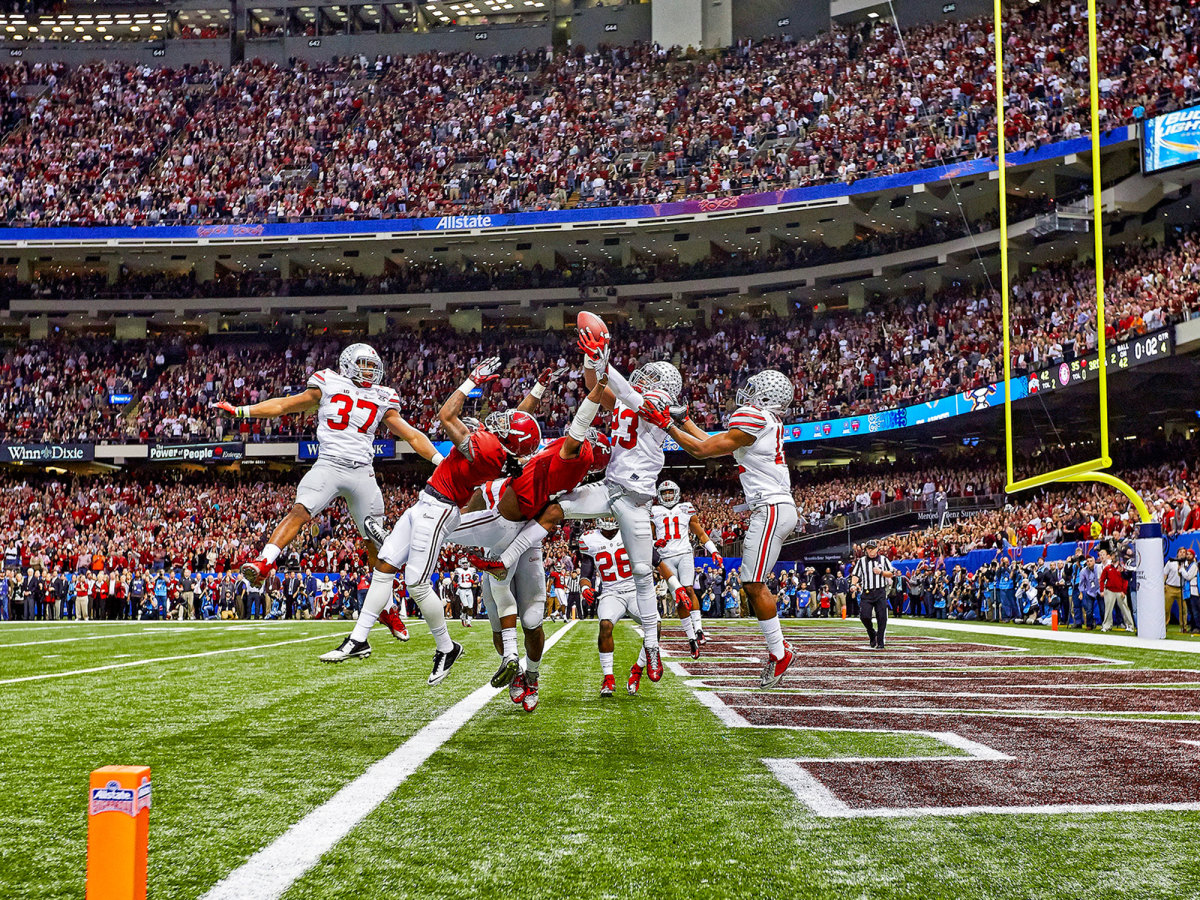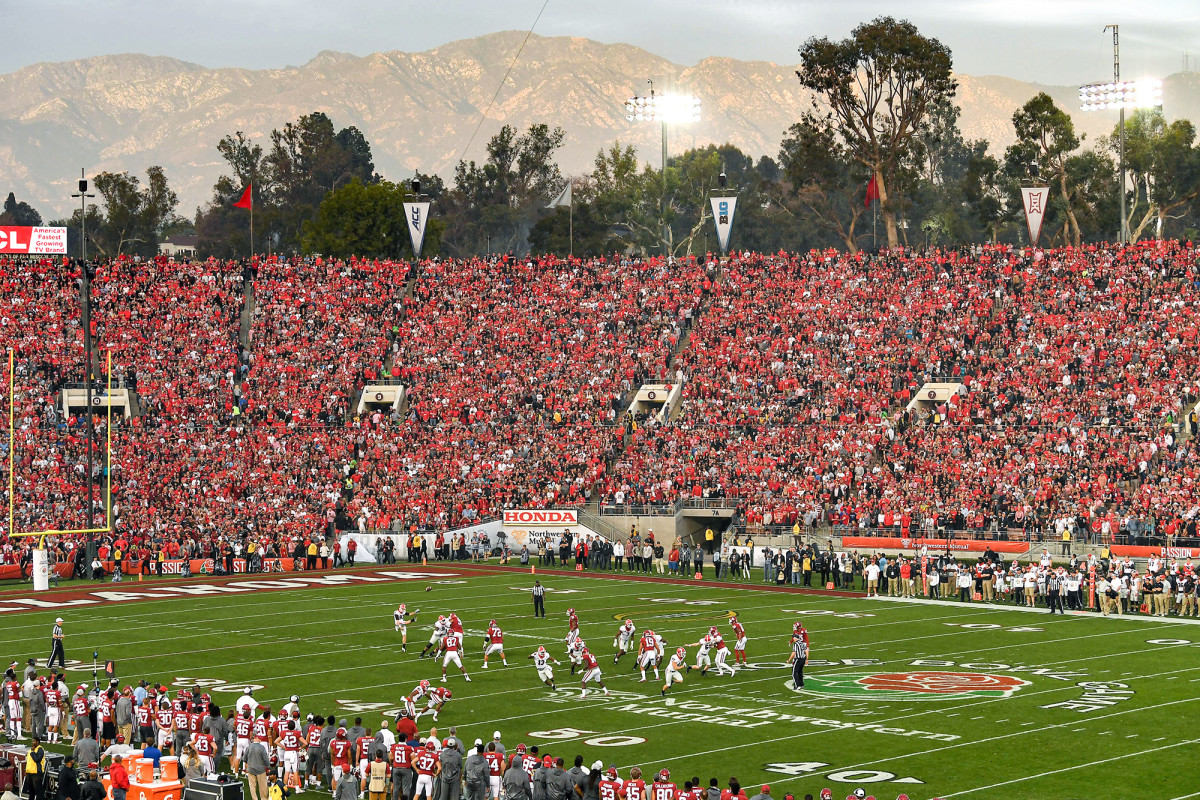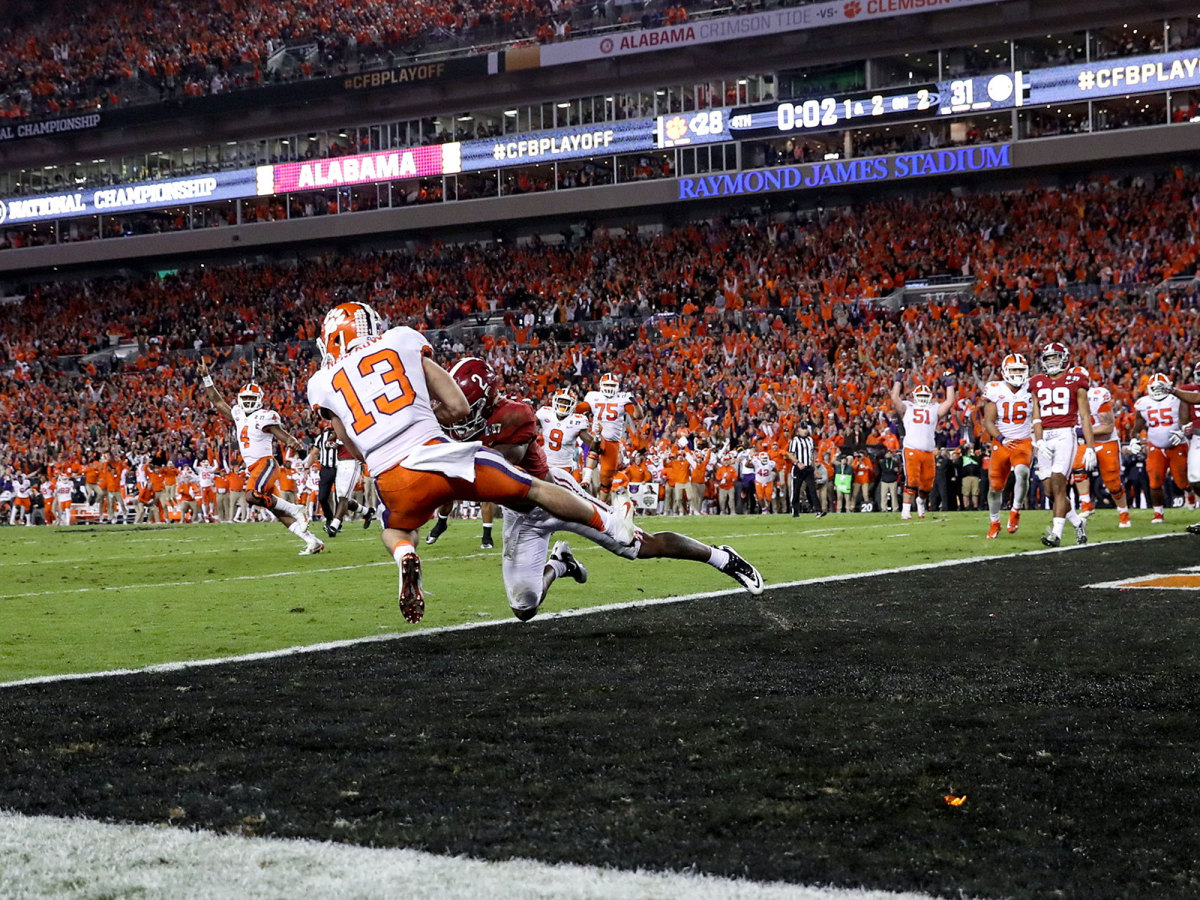The Five Best Games in College Football Playoff History
Earlier this week, I covered the best game ever for each of the New Year’s Six bowls—excluding the College Football Playoff. Now it’s time to cover those Playoff games.
Counting them down, from five to one:
5. Ohio State 42, Alabama 35: 2014 Sugar Bowl semifinal
Ezekiel Elliott’s “85 yards through the heart of the South” run is entrenched in Buckeyes lore as the play that clinched a major upset and propelled Ohio State toward its most recent national championship. With the Buckeyes holding a 34–28 lead and less than four minutes remaining, Elliott took a handoff left, cut upfield and ran away from the Alabama defense to put the game away.
Ohio State’s very presence in that first Playoff was a point of great controversy. Heading into the final CFP rankings, the 11–1 Buckeyes were fifth and led by third-string quarterback Cardale Jones in the Big Ten championship game against Wisconsin. Earlier in the day, third-ranked TCU demolished Iowa State 55–3, seemingly locking up a bid, but then Ohio State beat the Badgers 59–0, and the selection committee vaulted the Bucks into the Playoff over the Horned Frogs (a moment that lived in infamy in Fort Worth until this season).

Top seed Alabama was expected to win fairly easily over Ohio State in the Sugar Bowl, but after the Bucks fell behind 21–6 in the second quarter everything turned around. Jones led two long scoring drives to make it 21–20 at halftime, then added another one to start the third quarter for a 27–21 lead. When Alabama quarterback Blake Sims served up a pick-six later in the third to make it 34–21, the upset started to crystallize.
Still, the Crimson Tide weren’t done. They scored one touchdown to make it 34–28, and a 21-yard Ohio State punt when backed up to its own 2-yard line seemingly set up Alabama to regain the lead. That’s when Sims threw a first-down interception—with Tide fans howling at offensive coordinator Lane Kiffin for not using running back Derrick Henry—and Alabama’s momentum was gone.
Six minutes later, Elliott slashed through the South. Ohio State was on its way to the championship game, where it defeated Oregon for the title.
4. Alabama 45, Clemson 40: 2015 title game
The Tigers pushed Bama to the point where Nick Saban had to do something risky—arguably the biggest gamble of his unmatched career. A fourth-quarter onside kick in a tie game turned the Tide.
Struggling to stop Deshaun Watson and the Clemson offense, Saban followed a tying field goal with 10½ minutes left by calling for a popped-up kickoff by Adam Griffith just past the initial line of the Tigers’ return unit. Defensive back Marlon Humphrey sprinted down and caught it over his shoulder, and Alabama retained possession.
Two plays later, Jake Coker hit tight end O.J. Howard for a 51-yard touchdown. That made it 31–24, and the Tide never trailed again. The service break on the onside kick was crucial.

Saban said he “felt like if we didn’t do something or take a chance to change the momentum of the game that we wouldn’t have a chance to win.”
The victory gave Saban his fifth national title while also stamping Clemson as Alabama’s biggest threat of the Playoff era. The two would go on to meet again in 2016 (see below), ’17 and ’18, with the programs splitting those four meetings.
3. Georgia 54, Oklahoma 48: 2017 Rose Bowl semifinal
This was the first overtime game in Playoff history, and they made it a double. In a shootout marked by wild momentum swings, the Bulldogs made the last big play in the second OT—blocking an Oklahoma field goal—and won it two plays later on a Sony Michel touchdown run.
For most of the first half, Georgia was simply trying to weather the Sooners’ offensive storm and not get blown out of the stadium. Baker Mayfield led touchdown drives of 80, 75, 69 and 90 yards in the first two quarters, and Oklahoma had a 31–14 lead with six seconds left in the half before Lincoln Riley made a decision that gave the Bulldogs a glimmer of hope and momentum.

He ordered a squibbed kickoff, and Georgia’s Tae Crowder snagged it and fell on the ball immediately near midfield. That gave the Dogs a chance to throw a short pass for field goal position, and Rodrigo Blankenship bombed one in from 55 yards out to change the tenor of the game.
After halftime Georgia scored 21 consecutive points to take the lead; Oklahoma came back with 14 straight to regain the advantage. Jake Fromm guided the Dogs downfield, and Nick Chubb finished the drive with the tying touchdown in the final minute, forcing overtime.
Georgia pulled it out from there, winning the highest-scoring game in Playoff history. “A hell of a college football game,” Riley said. “An epic Rose Bowl game.”
2. Clemson 35, Alabama 31: 2016 title game
Clemson’s ultimate two-minute drill—a nine-play, 68-yard drive that ended with a last-second touchdown pass from Watson to Hunter Renfrow—returned the Tigers to the sport’s summit for the first time in 35 years. Watson completed six passes to four different receivers against the nation’s No. 1 defense, with the final two yards covered on a rub route into the corner to former walk-on Renfrow.
The game served as revenge for Clemson after losing a thriller the year before in the title game to the Crimson Tide (see No. 4 above). And it served as final validation as an elite coach for Dabo Swinney, an Alabama alum.
“The paw is flying on top of that mountain tonight,” Swinney said, florid rhetoric pouring forth. “We saw the top of it last year, didn’t quite get there. Tonight we took that next step.”

It took a long time to get there. For most of the game the Tide dominated, and Clemson fought to stay close.
The Tigers didn’t score on their first five possessions, falling behind 14–0, and trailed by 10 points going into the fourth quarter. But Watson was brilliant in leading three long scoring drives. Clemson took its first lead at 28–24 with 4:38 remaining, only to have Jalen Hurts answer. His 30-yard touchdown run with just more than two minutes to play set the stage for the final drive that changed the trajectory of Clemson football.
“Let’s be legendary,” Watson told his receivers before taking the field. “Let’s be great.”
1. Alabama 26, Georgia 23: 2017 title game
A walk-off national championship. Not just that, but a walk-off bomb for the national championship. From a backup freshman quarterback to a backup freshman wide receiver.
It was all so shocking that it provoked a spontaneous burst of joy from Saban, who is normally not prone to such things. Saban pulled the headset off his ears and started running, while the rest of the Alabama sideline erupted around him.
Meanwhile at midfield, the freshman who threw the pass, Tua Tagovailoa, was a momentary picture of calm. He watched DeVonta Smith pull in the pass and cross the goal line for the winning score, lifted his right index finger in the ear, patted his chest two times, looked skyward with his index finger aloft again, removed his helmet and was engulfed by euphoric teammates.

At that point, Tagovailoa and Smith were far from the all-time college greats they would become. Tagovailoa was the emergency backup who relieved a struggling Hurts, a desperate but necessary move by Saban with his team trailing 13–0 at halftime. Smith was just a small light in a galaxy of Alabama skill-position stars, alongside Jerry Jeudy, Calvin Ridley, Henry Ruggs III, Najee Harris, Damien Harris, Bo Scarbrough and Irv Smith Jr.
Years later, Tagovailoa would become a Heisman Trophy finalist and a top-five NFL draft pick. Smith would win the Heisman and be picked 10th. On that stressful night in Atlanta, they were improbable heroes.
Tagovailoa led two fourth-quarter scoring drives to tie the game at 20, while the Alabama defense shut down Georgia over its final five possessions of regulation. The Tide once more kept the Bulldogs out of the end zone in overtime, but their chances appeared to be slim after Tagovailoa took a potentially game-losing sack on Alabama’s first play of overtime.
Instead, that only set the stage for the most famous offensive play in school history, commonly known as second-and-26. With four players running vertical routes, Tagovailoa looked off safety Dominick Sanders to keep him in the middle of the field, then fired deep for Smith down the left sideline. The ball left Tagovailoa’s left hand at the 47-yard line and hit Smith’s hands at the 1, and his next stride took him into the end zone to end the game and deliver the title.
“After the sack, we just got up and took it to the next play,” Tagovailoa said. “I looked back out, and he was wide open. Smitty was wide open.”
Watch college football with fuboTV. Start your free trial today.
